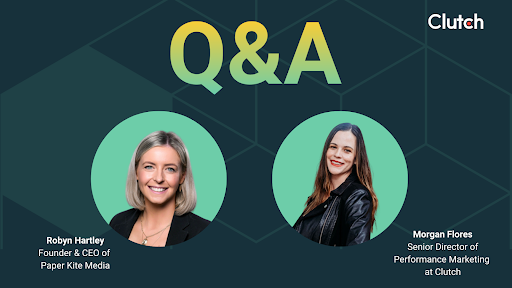![How to Create a Digital Marketing Budget [With Template]](https://img.shgstatic.com/clutch-static-prod/image/resize/715x400/s3fs-public/article/cbefcf801b6c486982d781482f9a654f.png)
![How to Create a Digital Marketing Budget [With Template]](https://img.shgstatic.com/clutch-static-prod/image/resize/715x400/s3fs-public/article/cbefcf801b6c486982d781482f9a654f.png)
Updated March 26, 2025
In this interview, Robyn Hartley, Founder of Paper Kite Media, discusses the impact of AI on building authentic thought leadership within the B2B marketing space. Take a few moments to listen as she breaks down the importance of maintaining authenticity in content, noting that while AI can save time, it lacks the human touch needed to build trust and resonance with buyers.

In this video, you’ll learn:
Looking for a Digital Marketing agency?
Compare our list of top Digital Marketing companies near you
Search for industry-leading social media marketing companies on Clutch. Read client reviews to find the perfect partner for your upcoming social media project.
Before we dive in, Robyn, could you take us through your story of how you began your career in development and what encouraged you to build your own company?
Robyn Hartley [00:00-3:09]: Yeah, of course! Great question. I’ve worked in marketing for over a decade—about 12 years—gaining experience on both the client and agency sides. Most of my work has been in B2B, supporting large enterprise tech organizations. In recent years, I felt a strong desire to build something of my own. Looking at the market, it’s clear that social media has become increasingly influential in buyers' decision-making. Influencer marketing is evolving rapidly, thought leadership is more engaging than ever, and the sales journey looks very different from 5–10 years ago. But one thing remains true: people trust people. I’ve always been active on LinkedIn and have seen firsthand how visibility creates professional opportunities. I knew this would be valuable for B2B brands and their teams, so I took the leap and launched my business. It’s dedicated to helping B2B brands adapt to these changes, build trust with buyers authentically, and support their teams in growing their professional presence. For now, I’m primarily focused on the UK, but my past agency work has been on a global scale, and I plan to expand over time. Starting a business is a huge leap, and it means a lot to see it working out and to share my knowledge with others!
When working with brands and their strategies, what discussions are you guys having regarding AI?
Robyn Hartley [5:59-6:25]: Most of our conversations focus on using AI productively to save time and improve processes. At the same time, we emphasize tools and strategies that preserve the human touch in content creation. Ultimately, that’s what builds connection, trust, and resonance with buyers.
You have experience working directly with B2B brands and agencies to build authentic relationships with buyers. AI is here – do you feel some companies have damaged their authenticity by relying too much on AI? What approaches do you recommend for fostering responsible AI use while leveraging subject matter experts?
Robyn Hartley [7:08-9:41]: Many brands now recognize social media's role in B2B buying, with employee advocacy being a huge opportunity. It benefits both brands, by leveraging employees' networks, and individuals, by boosting their industry credibility. There are barriers—teams are busy, unsure what to write, or lack confidence in posting. AI seems like an easy solution for generating content quickly. However, it often prioritizes quantity over quality. If competitors produce authentic content while you rely too heavily on AI, you risk blending into the background or damaging your reputation.
Many overlook the importance of personalization and understanding buyers' challenges. AI can provide a starting point, but lacks the deep market insight and unique perspectives that make content truly valuable. This affects not just engagement but also sales cycles and RFP invitations.
Some companies lean too heavily on AI in advocacy programs, but as the market matures, we'll likely see a shift toward more strategic use—training teams to be authentic and genuinely present in their industry.
Do you think B2B brands are lagging in leveraging video for engagement, and have you noticed strong results for those that do?
Robyn Hartley [10:02-11:42]: It's difficult to rely on AI for video content. Not everyone feels confident on camera, but the person-to-person aspect is powerful. Seeing someone speak creates familiarity and builds resonance.
Key strategies involve time, training, and opportunity. Making time for development, promoting learning, and encouraging conference attendance expands market knowledge while fostering new perspectives and industry connections that provide valuable content. Support team members interested in writing blogs, speaking at events, or hosting client roundtables. Promote curiosity by asking questions, thinking critically, and celebrating diverse perspectives to spark meaningful discussions. Training remains most crucial—confident people are more likely to participate and invest in the process. Connecting your team with the right support to improve is worth the investment.
When you're evaluating the impact and reach of content, what has made more impact for businesses? Are there particular common threads that you're finding that, in B2B, are just really performing well, whether it’s AI generated or human produced content?
Robyn Hartley [12:32-14:39]: Video is a big one, as you mentioned. LinkedIn is currently pushing video heavily, and those willing to step into that space are seeing strong engagement. Video creates a person-to-person connection, making content feel more authentic.
It all comes back to authentic content—sharing real experiences, genuine buyer insights, and meaningful conversations. That’s what drives higher engagement. I see it with my clients—the content that resonates emotionally is what prompts reactions, comments, and shares.
When it comes to metrics, many focus on likes and comments, but it's important to set clear expectations from the start. What do you really want to achieve? Are you looking to generate leads, expand existing accounts, retain clients, or all of the above? There are also personal KPIs—appearing on an industry podcast, connecting with respected professionals, or even earning a promotion. Defining success might mean rethinking KPIs, incorporating factors like retention, advocacy, and industry reputation. There’s a long list of possible metrics, but ultimately, it’s about aligning them with real business and personal goals.
It wouldn't bore me—I love analyzing different levels of indicators and metrics and connecting them to company objectives, which usually tie to revenue. What often intimidates people is creating content with clear bottom-line impact. But there are effective approaches, and you've provided excellent starting points for that next step.
Robyn Hartley [15:11-16:09]: Yeah, and it’s always really difficult to attribute these things, right? But it could be as simple as training your team to use UTMs so they can start tracking links they share around branded releases and similar content. It might also mean adding custom fields to your CRM and training customer success and sales teams to note when thought leadership, LinkedIn posts, or other content are mentioned, allowing you to flag those as touchpoints. There are definitely ways to do it, and it also impacts the rest of your marketing channels by amplifying everything else you’re doing. If you implement something on a specific date, tracking all your other channels can help identify any spikes or consistent growth.
What brand do you think is really successful right now and just killing it with their thought leadership content?
Robyn Hartley [16:31-17:11]: It’s a very good question. There are so many doing well at the moment, but one that always stands out—and that I reference frequently—is IBM. They train their whole team in thought leadership content, and it seems like they’ve been doing it for years.
Their employees are at the heart of everything they produce on the branded content side, and many of their experts worldwide have built large LinkedIn communities by consistently sharing valuable content with their audiences. So yes, I would have to say IBM.
Next question for you, what's your favorite app for consuming content?
Robyn Hartley [17:19-17:38]: I mean, I have to say LinkedIn, don’t I? It’s my go-to, so I’ll definitely say LinkedIn. But I’ve also started dabbling with BlueSky and testing B2B reels on other social media platforms like Instagram.
Do you have a favorite podcast as well?
Robyn Hartley: [18:58-19:31] I’m a big podcast person—I love listening to them. There are so many I follow, but two in particular that I really enjoy are *B2Better* and *Blame It on Marketing*. Both are run by wonderful people I’ve met who are not only lovely but also highly knowledgeable in B2B. They feature interviews on a wide range of topics with industry leaders, making them both insightful and a great way to learn.

Robyn Hartley works directly with B2B brands and agencies to build strong authentic relationships with buyers through effective thought-leadership strategies. Her agency specializes in helping B2B brands drive sustainable growth through thought-leadership strategies, helping to reduce sales cycles, improve win rates and reduce overall customer acquisition costs.
Interviewed by: Morgan Flores, Sr. Director of Performance Marketing
![How to Create a Digital Marketing Budget [With Template]](https://img.shgstatic.com/clutch-static-prod/image/resize/715x400/s3fs-public/article/cbefcf801b6c486982d781482f9a654f.png)

